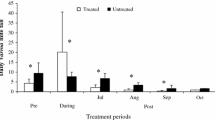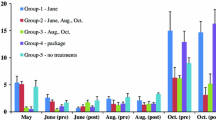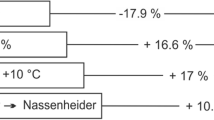Abstract
Bee colonies in southern France were treated with conidia (asexual spores) from two strains of Beauveria bassiana, an entomopathogenic fungus. One strain was commercial (GHA) and the other had been isolated from Varroa mites in the region (Bb05002). Objectives were to evaluate treatment effect on colony weight, adult bee mass, capped brood, and on Varroa fall onto sticky boards. Treatments included conidia formulated with either carnauba or candelilla wax powder, candelilla wax powder alone, or control; in two treatment groups formulation was applied a second time after one week. Treatment did not affect colony health. Colonies treated twice with Bb05002 conidia and carnauba wax powder had significantly higher mite fall compared to colonies treated with blank candelilla wax powder. The proportion of fallen mites that were infected in both conidia treatments was higher than controls for 18 days after the second treatment. The number of fungal propagules on the bees themselves remained elevated for about 14 days after the second treatment. These results were compared to published results from previous experiments with regard to infection duration.




Similar content being viewed by others
References
Burges HD (1998) Chapter 4. Formulation of mycoinsecticides. In: Burges HD (ed) Formulation of microbial biopesticides: Beneficial microorganisms, nematodes and seed treatments. Kluwer Academic Publishers, Dordrecht, The Netherlands
Chandler D, Sunderland KD, Ball BV, Davidson G (2001) Prospective biological control agents for Varroa destructor n. sp., an important pest of the European honey bee, Apis mellifera. Biocontr Sci Technol 11:429–448
Cherry A, Jenkins N, Heviefo G, Bateman RP, Lomer C (1999) A West African pilot scale production plant for aerial conidia of Metarhizium sp. for use as a mycoinsecticide against locusts and grasshoppers. Biocontr Sci Technol 9:35–51
Davidson G, Phelps K, Sunderland KD, Pell JK, Ball BV, Shaw KE, Chandler D (2003) Study of temperature-growth interactions of entomopathogenic fungi with potential for control of Varroa destructor (Acari: Mesostigmata) using a nonlinear model of poikilotherm development. J Appl Microbiol 94:816–825
Fakhimzadeh K (2001) Effectiveness of confectioner sugar dusting to knock down Varroa destructor from adult honey bees in laboratory trials. Apidologie 32:139–148
Fargues J, Maniania NK, Delmas JC, Smits N (1992) Influence de la temperature sur la croissance in vitro d’hyphomycetes entomopathogenes. Agronomie 12:557–564
Goettel MS, Inglis GD (1997) Fungi: Hyphomycetes. In: Lacey L (ed) Manual of techniques in insect pathology. Academic Press, San Diego, CA, USA
Hong TD, Ellis RH, Gunn J, Moore D (2002) Relative humidity, temperature, and the equilibrium moisture content of conidia of Beauveria bassiana (Balsamo) Vuillemin: a quantitative approach. J Stored Prod Res 38:33–41
Hong TD, Gunn J, Ellis RH, Jenkins NE, Moore D (2001) The effect of storage environment on the longevity of conidia of B. bassiana. Mycol Res 105:597–602
James RR, Hayes G, Leland JE (2006) Field trials on the microbial control of Varroa with the fungus Metarhizium anisopliae. Am Bee J 146:968–972
Jaronski ST, Goettel MA, Lomer C (2004) Chapter 12. Regulatory requirements for ecotoxicological assessments of microbial insecticides - how relevant are they? In: Hokkanen H, Hajek A (eds) Environmental impacts of microbial insecticides: Need and methods for risk assessment. Kluwer Academic Publishers, Dordrecht, The Netherlands
Jones KA, Burges HD (1998) Chapter 2. Technology of formulation and application. In: Burges HD (ed) Formulation of microbial biopesticides: Beneficial microorganisms, nematodes and seed treatments. Kluwer Academic Publishers, Dordrecht, The Netherlands
Kanga LHB, Jones WA, James RR (2003) Field trials using the fungal pathogen, Metarhizium anisopliae (Deuteromycetes: Hyphomycetes) to control the ectoparasitic mite, Varroa destructor (Acari: Varroidae) in honey bee, Apis mellifera (Hymenoptera: Apidae) colonies. J Econ Entomol 96:1091–1099
Kanga LHB, Jones WA, Garcia C (2006) Efficacy of strips coated with Metarhizium anisopliae for control of Varroa destructor (Acari: Varroidae) in honey bee colonies in Texas and Florida. Exp Appl Acarol 40:249–258
Littell RC, Milliken GA, Stroup WW, Wolfinger RD (1996) SAS system for mixed models. SAS Institute, Cary, NC, USA
Lomer CJ, Prior C, Kooyman C (1997) Development of Metarhizium spp. for the control of locusts and grasshoppers. Mem Ent Soc Canada 171:265–286
Macedo PA, Wu J, Ellis MD (2002) Using inert dusts to detect and assess Varroa infestations in honey bee colonies. J Apic Res 41:3–7
Martin S (1998) A population model for the ectoparasitic mite Varroa jacobsoni in honey bee (Apis mellifera) colonies. Ecol Model 109:267–281
Martin SJ (2001) The role of Varroa and viral pathogens in the collapse of honey bee colonies: a modelling approach. J Appl Ecol 38:1082–1093
Meikle WG, Jaronski S, Mercadier G, Quimby PC (2003) A distributed delay routine-based simulation model of Beauveria bassiana conidial stability in response to environmental stressors. Biocontrol 48:561–578
Meikle WG, Mercadier G, Girod V, Derouané F, Jones WA (2006) Evaluation of Beauveria bassiana (Balsamo) Vuillemin (Deuteromycota: Hyphomycetes) strains isolated from Varroa mites in southern France. J Apic Res 45:219–220
Meikle WG, Mercadier G, Holst N, Nansen C, Girod V (2007) Duration and spread of an entomopathogenic fungus, Beauveria bassiana (Balsamo) Viullemin (Deuteromycota: Hyphomycetes), used to treat Varroa mites, Varroa destructor Anderson and Trueman (Acari: Varroidae), in honeybee colonies. J Econ Entomol 100:1–10
Meikle WG, Mercadier G, Holst N, Nansen C, Girod V (2008) Impact of a treatment of Beauveria bassiana (Deuteromycota: Hyphomycetes) on honeybee (Hymenoptera: Apidae) colony health and on Varroa mites (Acari: Varroidae). Apidologie. doi:10.1051/apido:20007057
Rinderer TE, de Guzman LI, Delatte GT, Stelzer JA, Lancaster VA, Kuznetsov V, Beaman L, Watts R, Harris JW (2001) Resistance to the parasitic mite Varroa destructor in honey bees from far-eastern Russia. Apidologie 32:381–394
Shaw KE, Davidson G, Clark SJ, Ball BV, Pell JK, Chandler D, Sunderland KD (2002) Laboratory bioassays to assess the pathogenicity of mitosporic fungi to Varroa destructor (Acari: Mesostigmata), an ectoparasitic mite of the honeybee, Apis mellifera. Biol Contr 24:266–276
Simpson J (1961) Nest climate regulation in honey bee colonies. Science 33:1327–1333
Southwick EE (1991) The colony as a thermoregulating superorganisms. In: Goodman LJ, Fisher RC (eds) The behavior and physiology of bees. CAB International, Wallingford, UK
Tanada Y, Kaya HK (1993) Insect pathology. Academic Press, San Diego, CA, USA
Winston ML (1987) The biology of the honey bee. Harvard Univ Press, Cambridge, MA, USA
Acknowledgments
The authors would like to thank F. Annas for help in the field; S.T. Jaronski for supplying the GHA material; K. Hoelmer and W.A. Jones for constructive comments on the manuscript, and three anonymous reviewers for help in improving the manuscript.
Author information
Authors and Affiliations
Corresponding author
Rights and permissions
About this article
Cite this article
Meikle, W.G., Mercadier, G., Holst, N. et al. Impact of two treatments of a formulation of Beauveria bassiana (Deuteromycota: Hyphomycetes) conidia on Varroa mites (Acari: Varroidae) and on honeybee (Hymenoptera: Apidae) colony health. Exp Appl Acarol 46, 105–117 (2008). https://doi.org/10.1007/s10493-008-9160-z
Received:
Accepted:
Published:
Issue Date:
DOI: https://doi.org/10.1007/s10493-008-9160-z




